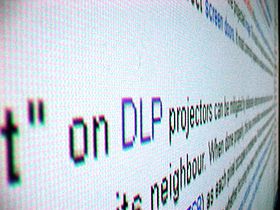212:(DLP) projectors can be mitigated by deliberately setting the projected image slightly out of focus, which blurs the boundaries of each pixel to its neighbor. This minimizes the effect by filling the black pixel perimeters with adjacent light. Some older LCD projectors have a more noticeable screen door effect than first generation DLP projectors. Newer DLP chip designs promise closer spacing of the mirror elements which would reduce this effect; however, some space is still required along one edge of the mirror to provide a control circuit pathway. Use of Dolgoff's depixelization method could also produce a DLP projector without noticeable pixelation.
205:
green pixels (appearing bright) adjacent to red and blue pixels (appearing dark), forming a noticeable repeating light and dark pattern. Use of a micro-lens array at a slightly greater distance created new pixel images, with each "new" pixel being a summation of six neighboring sub-pixels (made up of two full color pixels, one above the other). Since there were as many micro-lenses as there were original pixels, no resolution was lost, which was confirmed with modulation transfer function (MTF) measurements.
124:
25:
204:
array, wherein each micro-lens caused a slightly magnified image of the pixel behind it, filling in the previously-visible spaces between pixels. In addition, when making a projector with a single, full-color LCD panel, an additional appearance of pixelation was visible due to the noticeability of
188:
than the size of the image they project, enlarging these fine lines, which are much smaller than the pixels themselves, to be seen. This results in an image that appears as if viewed through a fine screen or mesh such as those used on anti-insect
159:
images and regular displays under magnification or at close range, but the increases in display resolutions have made this much less significant. More recently, the screen door effect has been an issue with
196:
The screen door effect was noticed on the first digital projector: an LCD projector made in 1984 by Gene
Dolgoff. To eliminate this artifact, Dolgoff invented de
226:
281:
200:, which used various optical methods to eliminate the visibility of the spaces between the pixels. The dominant method made use of a
89:
61:
68:
42:
108:
75:
57:
46:
321:
168:, because these are viewed at a much closer distance, and stretch a single display across a much wider
326:
209:
289:
161:
35:
184:
and DLP projectors, SDE can be seen because projector optics typically have significantly lower
82:
263:
165:
8:
242:
232:
306:
156:
221:
140:
315:
185:
169:
197:
190:
237:
201:
123:
24:
148:
152:
144:
181:
229:, an artifact associated with single-chip DLP projectors
49:. Unsourced material may be challenged and removed.
307:Hi Fi Writer, "What is the 'screen door effect'?"
313:
261:
143:of displays, where the fine lines separating
109:Learn how and when to remove this message
122:
127:Demonstration of the screen door effect
314:
175:
47:adding citations to reliable sources
18:
13:
151:) become visible in the displayed
14:
338:
300:
23:
262:Greg Kumparak (26 March 2014).
34:needs additional citations for
282:"Home Theater: dlp versus lcd"
274:
255:
1:
288:. 18 May 2004. Archived from
248:
7:
264:"A Brief History Of Oculus"
215:
16:Visual artifact of displays
10:
343:
208:The screen door effect on
210:Digital Light Processing
162:virtual reality headsets
155:. This can be seen in
128:
166:head-mounted displays
126:
292:on 10 November 2013.
58:"Screen-door effect"
43:improve this article
322:Display technology
243:Subpixel rendering
233:Silk screen effect
133:screen-door effect
129:
176:SDE in projectors
157:digital projector
119:
118:
111:
93:
334:
327:Visual artifacts
294:
293:
278:
272:
271:
259:
222:Apple Vision Pro
114:
107:
103:
100:
94:
92:
51:
27:
19:
342:
341:
337:
336:
335:
333:
332:
331:
312:
311:
303:
298:
297:
280:
279:
275:
260:
256:
251:
218:
178:
141:visual artifact
115:
104:
98:
95:
52:
50:
40:
28:
17:
12:
11:
5:
340:
330:
329:
324:
310:
309:
302:
301:External links
299:
296:
295:
273:
253:
252:
250:
247:
246:
245:
240:
235:
230:
227:Rainbow effect
224:
217:
214:
177:
174:
117:
116:
31:
29:
22:
15:
9:
6:
4:
3:
2:
339:
328:
325:
323:
320:
319:
317:
308:
305:
304:
291:
287:
283:
277:
269:
265:
258:
254:
244:
241:
239:
236:
234:
231:
228:
225:
223:
220:
219:
213:
211:
206:
203:
199:
194:
192:
187:
186:pixel density
183:
173:
171:
170:field of view
167:
163:
158:
154:
150:
146:
142:
138:
134:
125:
121:
113:
110:
102:
91:
88:
84:
81:
77:
74:
70:
67:
63:
60: –
59:
55:
54:Find sources:
48:
44:
38:
37:
32:This article
30:
26:
21:
20:
290:the original
285:
276:
267:
257:
207:
198:pixelization
195:
191:screen doors
179:
136:
132:
130:
120:
105:
96:
86:
79:
72:
65:
53:
41:Please help
36:verification
33:
316:Categories
286:AllExperts
268:TechCrunch
249:References
164:and other
99:March 2014
69:newspapers
238:Scan line
202:microlens
149:subpixels
216:See also
139:) is a
83:scholar
145:pixels
85:
78:
71:
64:
56:
153:image
90:JSTOR
76:books
147:(or
131:The
62:news
182:LCD
180:In
137:SDE
45:by
318::
284:.
266:.
193:.
172:.
270:.
135:(
112:)
106:(
101:)
97:(
87:·
80:·
73:·
66:·
39:.
Text is available under the Creative Commons Attribution-ShareAlike License. Additional terms may apply.
